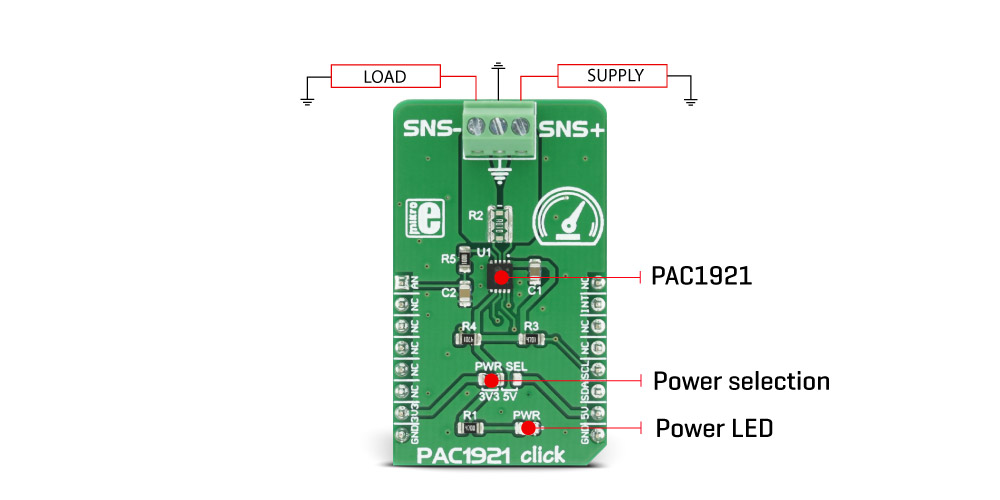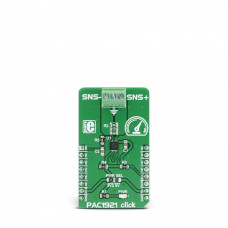PAC1921 click
PAC1921 click is a versatile power monitoring and measuring device intended for the high speed, low latency measurements. This device can measure current, voltage or the power of the connected load. PAC1921 click features an integrated average power measurement, it can output the measured properties in the form of a filtered analog voltage level by using 10bit DAC, provides 1x to 128x current binary gain, it has an integrated second order input ADC, automatic zero offset, and all the measured values are available through the serial SMBus/I2C interface.
With its very low margin of error, PAC1921 click is perfectly suited for measurement and monitoring of electrical properties in a wide range of different applications, such as the diagnostic equipment, power supplies, industrial and power management systems, notebook and desktop computers and similar applications where high speed, low latency measurements, and power monitoring is needed.
How does it work?
All the measurements on this click board™ are performed by the PAC1921, a high side power/current monitor from Microchip. The measurement is done by the SENSE+ and SENSE- pins, which are routed to the onboard terminals used for connecting the load. A shunt resistor of 10mΩ is also soldered between these two pins. The SENSE pins are very sensitive to the voltage and they can detect up to 100mV of across the shunt resistor. The OUT pin of the PAC1921 IC can be used to output an analog voltage, which corresponds to the selected measured electrical property - voltage, current or power. The full scale for the measurement can be set to 1V, 1.5V, 2V and 3V. The OUT pin of the IC is routed to the mikroBUS™ AN pin so that the host MCU can instantly read the measurement information without latency, common for the serial communication.
The load should be connected in series with the PAC1921 click so that the positive end of the power supply runs through the PAC1921 click SENSE+ terminal, SENSE- terminal and finally to the positive end of the load. Negative end (GND) of the load is connected to the ground. The voltage drop across the shunt resistor is used to measure the current flow through the load and it should not exceed 6A. When the voltage drop across the shunt resistor and its resistance are known, the current can be easily calculated. The voltage across the connected power supply is measured between the SENSE+ pin and the GND. The maximum voltage level between the SENSE+ and the GND rail should not exceed 32V. During the measurement, these values are stored in the appropriate registers and are used for the power calculation.

PAC1921 IC is able to integrate the measurements so that the average value can be calculated. The integration can be done in two modes: Free-Run mode and Pin Controlled mode.
Pin Controlled integration mode can be engaged by pulling the #READ/INT pin to a HIGH level. This pin is routed to the mikroBUS™ INT pin. The measured type in this mode is limited only to power readings. While the pin is held at a HIGH logic level or before 2048 measuring samples are made, the PAC1921 IC will perform an integration of the measured values. After the integration is over - either after 2048 samples are taken, or after the #READ/INT pin is pulled to a LOW logic level for the minimum update time at any moment, the registers are updated, and the calculated value is sent to the 10bit DAC of the OUT pin. Pulling the #READ/INT pin to a LOW logic level for a minimum update time will put the device into the Read mode, stop the integration process and send the value to the 10bit DAC of the OUT pin.
While working in Free-Run integration mode, besides the power measurement, it is possible to measure current and voltage, too. The Free-Run integration time depends on the selected measuring mode, filtering, resolution, and the number of samples, which is selectable to a maximum of 2048 samples. The filtering improves the signal quality but increases the integration time for 50%. Also, when less integration time is required, 11bit ADC conversion should be used instead of the 14bit, at a cost of decreased precision. When power reading mode is selected as the measurement type, both voltage and current registers will be updated, resulting in longer integration time. While the device stays in the integration mode, the information will be latched on the DAC of the OUT pin after each integration period. When the device enters the Read mode, the integration is interrupted, and the collected data is discarded. The device is able to enter the Read mode by setting the appropriate registers, too.
While integrating the measured values, the device will place the selected measured electrical property values into the accumulator registers. At the end of the integration period, this averaged value is sent to the output 10bit DAC of the OUT pin, so that it can be read by the host MCU. It is also available in the registers, in a form of the MSB/LSB and by using conversion formulas from the PAC1921 datasheet, this value can be directly converted to the physical value of the electrical property - ampers [A], volts [V] or watts [W].
All the required setup and config registers are described in the PAC1921 datasheet, in details. However, the provided click board™ library contains functions used to easily set up the device registers and read the measurements for the selected electrical property. The provided demo application can be used as a starting point or a reference for a custom design.
PAC1921 click features the onboard SMD jumper, labeled as the PWR SEL, which can be used to set the operating voltage and the logic level for the SMBus/I2C communication lines so that both 3.3V and 5V capable MCUs can communicate with the device. The communication lines are already equipped with the pull-up resistors so that the device is ready to be used out of the box.
Specifications
| Type | Measurements |
| Applications | Perfectly suited for measurement and monitoring of electrical properties in a wide range of different applications - diagnostic equipment, power supplies, industrial and power management systems, notebook and desktop computers, etc. |
| On-board modules | PAC1921, High-Side Power/Current Monitor with Analog Output |
| Key Features | Accurate and configurable measurement of electrical parameters, 10bit DAC routed to the analog pin output for latency free readings, smart average measurement integration available on both SMBus/I2C bus and analog output pin |
| Interface | Analog,GPIO,I2C |
| Input Voltage | 3.3V or 5V |
| Click board size | M (42.9 x 25.4 mm) |
Pinout diagram
This table shows how the pinout on PAC1921 click corresponds to the pinout on the mikroBUS™ socket (the latter shown in the two middle columns).
PAC1921 click electrical specifications
| Description | Min | Typ | Max | Unit |
|---|---|---|---|---|
| SENS differential input voltage range | 0 | 100 | mV | |
| Measured current range | 0 | 6 | A | |
| Measured voltage range | 0 | 32 | V | |
| ADC input resolution | 11 | 14 | bits | |
| DAC output resolution | 10 | bits |
Onboard settings and indicators
| Label | Name | Default | Description |
|---|---|---|---|
| LD1 | PWR | - | Power LED indicator |
| JP1 | PWR SEL | Left | Power supply voltage level selection: left position 3.3V, right 5V |
Software support
We provide a library for PAC1921 click on our LibStock page, as well as a demo application (example), developed using MikroElektronika compilers and mikroSDK. The provided click library is mikroSDK standard compliant. The demo application can run on all the main MikroElektronika development boards.
Library description
Initializes click driver functions and I2C bus driver. Offers options for single or block writing to registers and reading from registers. Also offers options for calculating power and different types of voltage in a different number of samples and different full-scale range. For more details check the documentation.
Key functions
float pac1921_getMeasurementData( const uint8_t data_type, const uint8_t nSamples, const uint8_t full_scale )- The function returns measurement data determined by the data_type parameter, which can be VSENSE (max 100mV), VBUS (max 32V) in mV, or VPOWER (max 320W) witch unit is W. One round of measurement consists of the determined number of samples.
void pac1921_blockReadReg( uint8_t register_address, uint8_t *data_buffer, uint8_t nBytes )- The function reads bytes from registers to buffer with start location determined by the register_address parameter.
void pac1921_singleWriteReg( uint8_t register_address, uint8_t transfer_data )- The function writes one byte of data to the register, determined by the parameter of the function.
The application is composed of three sections :
- System Initialization - Initializes peripherals and pins.
- Application Initialization - Initializes click driver.
- Application Task - (code snippet) - Gets VBUS measurement data which is measured in 512 samples.
Results are logged on the USB UART and measurement are repeated every 500ms.
void applicationTask()
{
data_read = pac1921_getMeasurementData( _PAC1921_VBUS_FREE_RUN, _PAC1921_512_SAMPLES );
FloatToStr( data_read, text );
mikrobus_logWrite( text, _LOG_TEXT );
if ( _PAC1921_UNIT == 0 )
{
mikrobus_logWrite( " mV", _LOG_LINE );
}
else
{
mikrobus_logWrite( " W", _LOG_LINE );
}
Delay_ms( 500 );
}
The full application code, and ready to use projects can be found on our LibStock page.
MikroElektronika Libraries used in the example:
- Conversions
- I2C
- UART
Additional notes and information
Depending on the development board you are using, you may need USB UART click, USB UART 2 click or RS232 click to connect to your PC, for development systems with no UART to USB interface available on the board. The terminal available in all MikroElektronika compilers, or any other terminal application of your choice, can be used to read the message.
mikroSDK
This click board is supported with mikroSDK - MikroElektronika Software Development Kit. To ensure proper operation of mikroSDK compliant click board demo applications, mikroSDK should be downloaded from the LibStock and installed for the compiler you are using.
For more information about mikroSDK, visit the official page.
Downloads
Enter the code in the box below:










